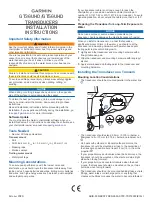
2
malfunction/operational defect or visible
damage, switch off the unit immediately and
secure it against unintended use.
•
The instrument may only be connected to
the mains via a socket that has an earth
connection.
•
Before making any connections, check the
experiment leads for damaged insulation
and exposed wires.
•
Replace a faulty fuse only with one matching
the specifications stated at the rear of the
housing.
•
Disconnect the equipment from the mains
before replacing a fuse.
•
Never short the fuse or the fuse holder.
•
Never cover the ventilation slots in the hous-
ing. This is necessary in order to ensure suf-
ficient circulation of air required for cooling
the internal components of the equipment.
•
The equipment may only be
opened/repaired by qualified and trained
personnel.
2. Description
The transformer with rectifier provides small
voltages, switchable in twelve voltage steps,
with outputs in the form of AC voltages or full-
wave rectified DC voltages.
The maximum load for each output is 6 A. Both
outputs are protected against short-circuiting.
The transformer
with the item number 1001009
is for operation with a mains voltage of 115 V
(±10%), and the transformer with the item num-
ber 1001010 unit is for operation with a mains
voltage of 230 V (±10%).
3. Technical data
Mains voltage:
see rear of housing
Output voltage:
1 / 2 / 3 / 4 / 5 / 6 / 7 / 8 /
9 / 10 / 11 / 12 V AC/DC
Maximum load:
6 A
Primary fuse:
see rear of housing
Terminals:
4 mm safety sockets
Dimensions: 190x210x160
mm
3
ap-
prox.
Weight:
3 kg approx.
4. Operation
4.1 General information
•
The AC and DC outputs cannot be used at
the same time.
•
Connect the power cord to the transformer.
•
Before connecting the plug to the mains
supply, set the voltage selector switch to
one and switch-off the power switch.
4.2 Obtaining an AC voltage
•
Connect the load to the AC output sockets.
•
Set the voltage selector switch to give the
required voltage; if necessary connect a
voltmeter in parallel with the load.
•
Connect the unit to the mains supply and
switch on the power switch.
4.3 Obtaining a DC voltage
•
Connect the load to the DC output sockets.
•
Set the voltage control to give the required
voltage; if necessary connect a voltmeter in
parallel with the load.
•
Connect the unit to the mains supply and
switch on the power switch.
4.4 Overload safety switch
If the current is excessive or there is a short-
circuit between the output sockets, the overload
safety switch trips out and breaks the circuit.
•
If that occurs, correct the fault at the output
sockets and, after an interval of one minute,
press the overload safety switch back in.
4.5 Changing the fuse
•
Unplug the mains plug.
•
Remove the power cord from the trans-
former.
•
Lift out the fuse holder at the back of the
power supply unit using a flat tool such as a
screwdriver (see fig. 1).
•
Replace the fuse and reinsert the holder in
its socket.
5. Care and maintenance
•
Before cleaning the equipment, disconnect it
from its power supply.
•
Use a soft, damp cloth to clean it.







































